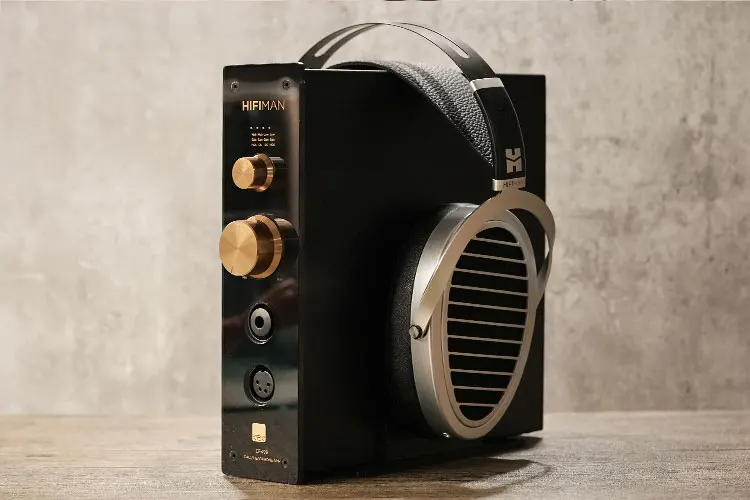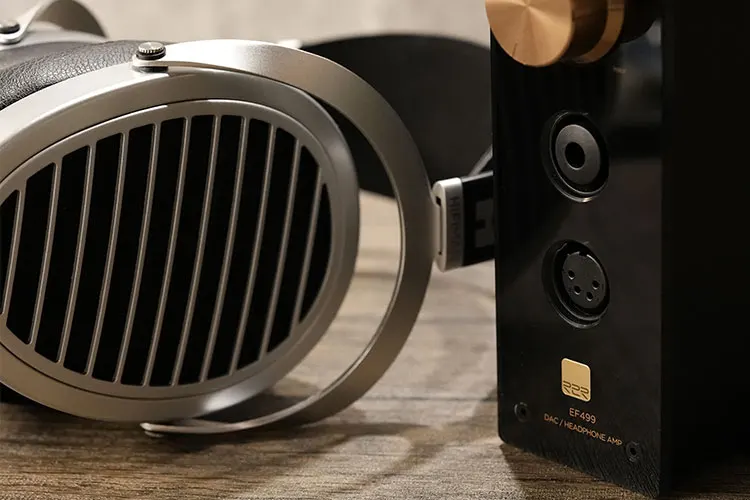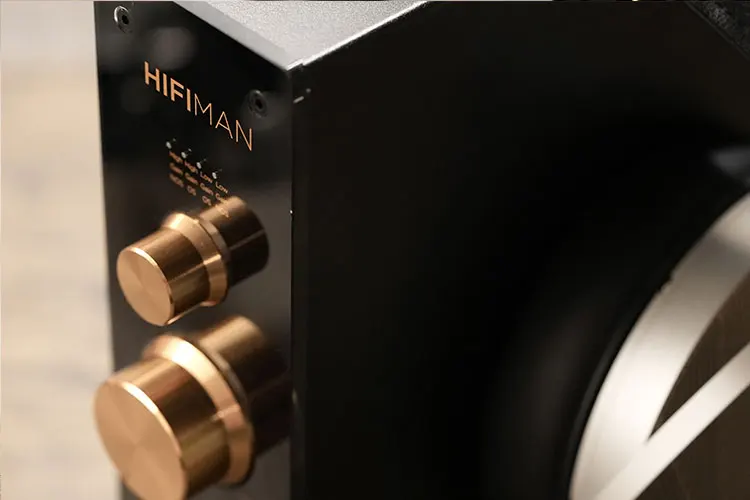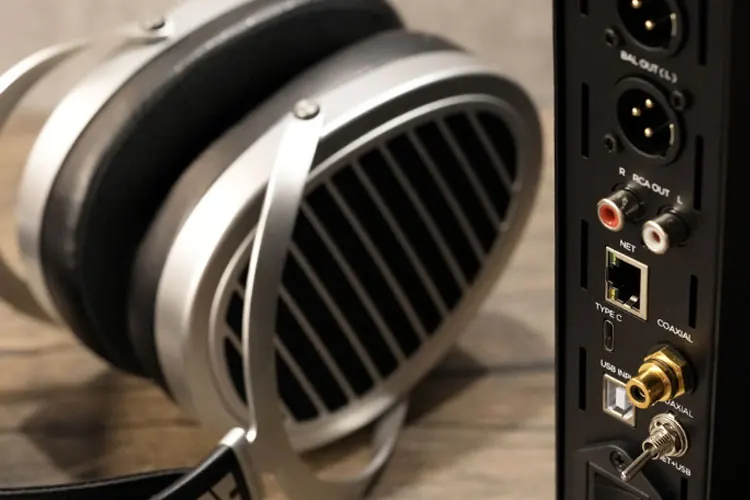In this feature, James reviews the HIFIMAN EF499, which is the company’s entry-level integrated R-2R DAC and balanced 4.35W-capable headphone amplifier. It is priced at $299.
Disclaimer: This sample was sent to me in exchange for my honest opinion. Headfonics is an independent website with no affiliate links or status. I thank the team at HIFIMAN for their support.
To read more about the HIFIMAN products we have previously reviewed on Headfonics click here.
Note, that this post follows our current scoring guidelines which you can read in more detail here.
After my recent review of the HYMALAYA R-2R-equipped HIFIMAN EF500 integrated DAC and headphone amplifier I now have the even more affordable EF499 for testing.
At $299 the only significant change is the replacement of the in-house HYMALAYA module with a tried and tested Philips R-2R DAC.
HIFIMAN claims that the tuning for the EF499 is similar and you also get the NOS/OS switching and streaming capabilities just as you would expect from the higher-tier EF500.
So how much difference should we expect in an amplifier just by swapping an R-2R chipset for another? You can find out how much in my full review and assessment below.
Tech Highlights
DAC
Unlike the high-profile HYMALAYA LE DAC, which is produced in-house by HIFIMAN, the decoding chipset for the EF499 is a Philips R-2R DAC.
However, from official materials, HIFIMAN only mentions it is a classic R-2R DAC from Philips with a warm and smooth signature and the tonality is similar to the HYMALAYA LE chips.
What I do know is that the EF499 Philips DAC supports up to DSD64 and PCM up to 24BIT/192kHz which is not top-shelf but should cover the majority of commercially available digital audio recordings.
The EF499 has a THD+N rating of 0.0008% and an S/N ratio of 99 dB, with channel separation measured at 95 dB.
This suggests that the Philips chipset might not be as dynamic or has more noise in the background compared to the HYMALAYA LE, but given the lower price point, it’s understandable.
We can guess from the output power the EF499 uses a similar, if not identical amping circuitry to the EF500, where the decoding stage is followed by discreet amplification and LPF for balanced output.
Certainly, the output power at 4.35W maximum into a 32Ω load balanced is marginally less than the EF500 suggesting such a claim might be true.
NOS
The NOS / OS knob is a unique feature that helps differentiate the EF499 from the competition. It enhances pairings by allowing an instant switch between two tonal profiles, either strengthening the mellow R-2R tone or boosting the transients and texture.
That said, the NOS that doesn’t alter the default sampling rate offers a more unaltered, organic presentation, whereas the OS mode that boosts the sampling rate is more focused on transients and gives a stronger sense of dynamics.
Streaming
The EF499 connects for streaming in the same manner as the EF500. Simply hook it up with an ethernet cable to the router, switch to NET+USB at the back of the EF499, and then you can select it from Roon as a Roon Bridge device.
Then, remote control the playback from your phone or tablet that is set as the Roon remote or endpoint.
The EF499 also supports other streaming applications. One of the simplest ways to enjoy the streaming feature is to download the player apps from your NAS manufacturer.
In my case, I tested the EF499 with Synology’s Audio Station, where you can select the EF499 as the output device just like connecting to a USB DAC from your PC.
Airplay Support
If you stream on your iPhone, iPad, or MAC then another must-try feature would be listening over Airplay. The EF499 supports various music apps such as Sony Select, Spotify, and QQ to name but a few.
This is a lot more convenient than traditional USB DACs as you don’t need local files and cables to configure the output. My experience streaming on the EF499 is so far very stable with a much better performance compared to Bluetooth streamers.
Design
The EF499 upright form factor is designed to double as a headphone stand or you can take out the screws to lie it flat if you are stuck for vertical space.
It swaps out the metallic front panel with a reflective, black acrylic one and uses golden knobs. With the Black and Gold theme, it looks arguably more luxurious than the bigger brother EF500, which has a cleaner matte silver finish.
Again, this is a heavy DAC/Amp for its size and at 3.3KG it feels extremely sturdy on the desk. The strong dampening should also effectively reduce vibrations and enhance the chipset’s performance.
Another aspect worth complimenting is the mode switch that allows circulating between high and low gain, as well as OS and NOS modes instantly. I like how it combines the OS/NOS modes and high/low gain settings so you can switch between these with one knob.
I/O
The front panel design seems to make it clear the EF499 is made for powering headphones with its prominent display of a balanced 4-pin XLR headphone jack and a 6.35mm SE output.
Aside from hooking up with a network device via an RJ45 socket to the rear, the EF499 functions as a normal R-2R USB Decoder.
You will find standard XLR LO and RCA jacks and a USB-C and USB-B port for USB-DAC duties on the rear panel. Additionally, you can hook up players via the coaxial input for a more traditional HiFi connection.
Packaging & Accessories
The EF499 comes in a thick cardboard box and is well protected with foams and the user manual is put on the label stuck on the box. You will also get a power cord but with not much else you will need to buy an ethernet or USB cable depending on your system setup.
Sound Impressions
The following sound impressions of the HIFIMAN EF499 were completed after over 100 hours of burn-in and paired with the HIFIMAN Ananda Nano, MOONDROP PARA, Sennheiser HD 650, and FiiO’s FT5 planar headphones.
Source playback was completed using TIDAL Max via a NAS connection.
Summary
While some R-2R gear has been accused of sounding soft or lacking in separation, the EF499 is not such a case.
HIFIMAN managed to strike a good balance between perceived clarity, texture, and timbre from the R-2R chipset, giving it a modern boost with powerful amping that enhances the responsiveness and the bite.
As a result, it sounds more open and extended yet preserves the dense, rich tone as expected from R-2R decoding. Interestingly, the EF499 tuning shares some similarities to the EF500 presentation, but with an even smoother, rounded, and rawer tone.
Timbre
You can instantly switch between OS and NOS modes, which allows the EF499 to suit different gears and music genres and is quite audible in the output. I prefer using the OS mode which sounds more textured and refined, while the NOS mode feels less altered and more relaxing.
I was intrigued if the Philips R-2R implementation would sound overly smoothened, but in practice, there is adequate resolution and vocal separation, with good dynamics.
Overall, the OS mode is slightly more resolving, while the NOS mode feels unaltered and more realistic.
OS
In OS, the EF499 sounds very well-articulated and rich in the bass and mids. The bass is punchy with a lot of air and density, an elaborated decay, and enough intensity to deliver rich and rounded bass elements without feeling constrained.
The energy of the vocal body in the mid-lows is nicely captured with an upper register vocal presence that offers great synergy with powerful voices such as Sia or Whitney Houston.
I also tested with Michael Bolton’s albums and powerful male vocals are delivered swiftly with adequate definition and penetration power.
NOS
When switched to NOS mode, the EF499 sounds more organic and focuses on the harmonics of the midrange instruments and vocals.
It may not sound as defined as the OS mode, but the smoothened presentation gets more mellow and engaging, which is more suitable if you want a relaxing listening session.
I like how the EF499 colors string instruments, harmonica, and accordions. They all sound very swift and immersive. However, the richness is a double-edged blade and the EF499 may struggle to remain as defined when more instruments join in.
The Ananda Nano from HIFIMAN is a good match sounding dense in the mids and very engaging with Tidal R&B mixes.
The output sounds open and expressive with Blues and string quartets, capturing the air and tension in the tunes quite well.
It doesn’t go very deep in the bass but instead, gives a light-hearted, responsive presentation that prioritizes richness over sharpness without coloring the output overly thick.
Staging & Dynamics
While the EF499 focuses on the midrange frequencies it doesn’t sound contained, rendering a rather spacious stage with adequate nuances captured by a slightly brightened treble tuning.
It feels like listening in a small lecture hall, where the virtuoso is not positioned that far. One thing to note is despite a rich bass presence, the vocals never feel overpowered by the lows.
There is a fair separation between the vocalist and the accompanying instruments which blend quite intimately, as expected from its R-2R implementation. The high amping power also lifts mid-treble frequencies which helps give the vocal a gentle push with improved clarity.
The tuning of the EF499 favors synthesized bass and vocals, with instruments across the mid-range sounding more stereophonic and well-elaborated in the body.
However, higher notes of string instruments or woodwinds may sound slightly dampened and rounded in comparison.
Click on page 2 below for my recommended pairings and selected comparisons.







